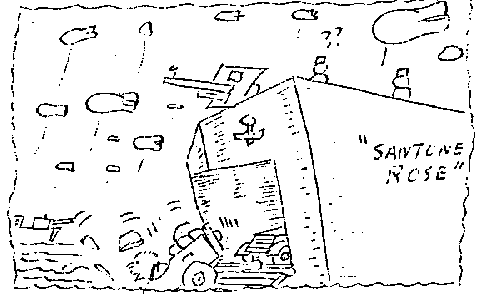

When Division Trains rolled ashore on Utah Beach of Normandy France on July 19th, the thrill of playing a vital roleon supplying the life line of one of the most modern and efficient Armored Divisions was being realized by every individual. We were entering Combat with pride and confidence. We knew not what to expect for our new venture was to be a far cry from the days of maneuvers and problems. It was no longer a series of monotonous make believe events. This was it!
As our mechanized columns thundered along the dusty, freshly-demined roads we became acutely aware of the uncertain potentialities never fully realized before. As we looked on either side of the orad the scars of battle were creating an indelible impression. Unsightly shell holes and bomb craters and smoking remnants of fire-torn towns and villages gave us a mental reception never to be forgotten. The humble and suffering civilians greeted us with tears in their eyes and joy in their hearts. We threw cigarettes and candy to them and waved at the little kids...innocent victims of a cruel fate. Thus we were being initiated into the fight...by seeing the horrors and utter devistation and destruction of war.
On the 30th of July the 3803 QM Truck Company joined Division Trains to assist in supplying the Division with gas and other necessary supplies. At 0530 Trains moved out in support of the Division in its drive that was to carry it to the outskirts of Brest. At 0845 Trains entered bivouac north of Lebingard, 21.8 miles from the old bivouac. After spending the night Trains moved from there at 0550 to an area 4 miles S.E. of Anneville, a distance of 21.1 miles. On the afternoon of the 31st, at 1830 hours, Trains left for an area north of Avranches in the vicinty of LeMesnil. The distance travelled on this move was 28 miles and the only activity was the appearance of a German Raconnaissance Plane.
On August 1, 1944, at 0100 hours, a German recon plane took photographs of the main supply route running adjacent to our bivouac area. We have all learned that the enemy takes arial photographs for only one purpose..to endeavor to cripple our supply lines and thereby neutralize the combat elements. We have all learned too, that the enemy has failed on every occasion to accomplish that purpose. Subsequently, on August 1st at 1330, Tns. area was attacked for the first time. 12 enemy planes attempted to inflict damage on the dumps situated in the fields. The area was straffed and one rocket was fired but it missed its target...hitting a barn some distance away. The planes turned and came back, strafing, sensing presumably that their luck would be better this time. That, however, is where they made their mistake. The 2d section, 1st Squad, of Btry C 777 AAA Bn made it quite warm for them and shot an empty rocket tube off one of the planes. The tube hit about 15 feet from the command half-track and CP. Shortly thereafter, the 777 boys inflicted their first casualty on the Luftwaffe on the Continent and a plane was seen plummeting to earth. That is when we all appreciated having a good AAA outfit...and a deep slit trench. During that onslaught three planes out of the twelve were shot down. I think that most of us were a little too dumbfounded at first to be scared, but it didn't take long to rehabilitate our senses and see if a shovel would join us in getting down under. Later that day another attack was staged by the Luftwaffe, but they were driven off by our planes and by AAA fire and caused only mild concern.
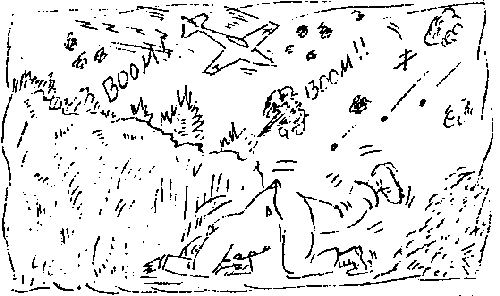
Late in the evening of August 1st at 2255 hours, Trains moved
form the bivouac area N.W. of Avranches for Precey, France, travelling
a distance of 12.9 miles. That was the night, as everyone vividly
remembers, that all Hell broke loose as German planes attempted to bomb
the river bridge at Avranches. They made their appearance at 0230
hours 2 August and straffed and bombed the column as we crossed the river,
and it seemed that they were dropping everything but the planes themselves.
A few of them may have dropped too. Only minor casualties and a good
scare resulted from the nightmare. At 0350 Trains entered the bivouac
area East of Precey. Throughout the remaining hours of darkness enemy
planes continued to bomb the bridge and strafe the area near our bivouac,
but there were no hits. Elements of the 79th Infantry Division were
marching into Avranches that night, giving the planes more reason for wanting
to serve a dual purpose. At the break of dawn, at 0600, the area
was again bombed and straffed, with no damage resulting. It wasn't
long after that that the first prisoner for Trains Hqs was taken.
Sgt. Ira H Jontz and Pfc Eugene Krohn of the Recon Plat brought in a German
Lt from a Panzer Grenadier Division. Being face to face with a German,
and especially an officer, was quite a novelty in these early days and
our curiosity was aroused. We stared at him and watched closely as
he was being searched and wondered just what made him tick. Being
a prisoner though, it didn't matter for his days of ticking were over.
On the morning of August 3d, at 0618 Tns moved from Precey arriving five hours later at the new bivouac, 1 nile East of Medreac, travelling a distance of 43.6 miles from the old area. Shortly after noon, at 1220, the Company took eight persons....quite a haul, we thought, as we threw out our chest in conspicuous pride. At 1600 a U.S. paratrooper visited Trains CP with messengers from the FF Underground, furnishing us with invaluable information and assistance. A half hour later word was received that Chaplain Schwer and his driver, Tech 5 Nelson, was missing in the vicinity of Huelgoat.
At 10 o'clock in the morning of August 4th, Trains encountered its first small arms fire. Rifle reports were heard in the vicinity of the gas dump and, shortly after snipers were captured by the 777th AAA. Negligible sniper fire was heard again at noon.

At 1700 Trains moved from the area East of Medreac, to its new bivouac at W Royal Pontivy, having travelled a distance of 51.1 miles. There was no activity here and our stay was short. The following afternoon, at 1730 on August 5th, Trains made another move. Due to enemy road blocks and Infantry, the route of march and the proposed bivouac area was changed.
At 8 o'clock that evening 38 prisoners along with a bus, were
taken by the Mil Police Platoon. The bus was later repainted and
converted into use by the 6th Armd Div Band. The original driver,
one of the Prisoners captured, named Emil, was retained to act in his old
capacity as chauffer. Six more PW's were taken later on by the 777th
AAA.
The 6th Armored Division's meteoric dash up the Brittany peninsula, traveling some 250 miles in ten days, was an unprecedented military achievement; but, while the Division was making history, Trains was taking no bows for conquering the innumerable problems of resupply...the life-line that can spell success or failure. Gasoline, consumed on an average of 100,000 gallons daily during the drive, was the main commodity. Trucks were on the roads day and night in order that the combat elements could continue the disruption of the enemy at a rapid pace.
The morning of August 8th at 1000, Trains was forced to dump 83,000 gallons of gasoline on the ground. The trucks were needed to haul more gas and that was the only solution. A section of the Band, including personnel from both the Attacker and Panther organizations, with Mr Thompson in charge, was detailed to guard the dumps--the cans being dispersed over an area of several fields. This detail ended in tragedy for one and severe injury to another. A report was received that on August 11th at 0100, the small group was attacked by an estimated 120 German paratroopers. Greatly outnumbered, the Bandsmen, after a brief exchange of carbine and machine gun fire, succeeded in repulsing and chasing away the enemy. This action was not without its casualties, for S Sgt William P Murray, "Tex" to all the boys, was killed. His passing was a great loss for he was well liked and respected by all who knew and worked with him. Tec 4 Ralph Jackson, trombonist, was hit in several places and after being given first aid, was evacuated.
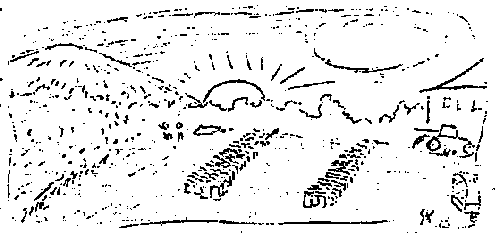
Both men were from Mr Sagan's Panther Band. Two tankmen
from the 15th Tank Battalion were also killed in this brief battle.
The enemy succeeded in burning 5,000 gallons of gas and destroying a light
tank and Tec 5 Louis Albertini's 2 1/2 ton truck.
On August 9th several units under Tns command contributed generously to the prisoner bag. At noon the 76th Med Bn took 65 PW's, and six hours later accounted for 235 more. At 1800 the 128th Ordnance Maintenance Bn took 150 prisoners, followed by a later haul of around 200. The next day, at 0800, 451 PW's were taken by the 990th Bridge Company.....a total of 1131 prisoners were thus credited to Trains for the 20 hour period.
The move to Plouvien was the longest that Trains made in the Division's
drive to the outskirts of Brest.
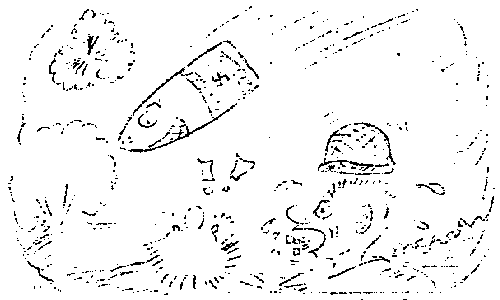
The fire came from the East and was believed to have been directed from an observation post somewhere in the town situated to our right. An investigation was made and a suspect--a French collaborator was questioned and sent to the PW cage.
Giving credit where credit was overlooked it might be well to mention that during the shelling, when everyone was seeking cover and concealing themselves wherever possible, Tec 5 Robert Hughes, operator on duty in the S-3 half-track, conscientiously remained beside his radio during the entire action...a commendable act of loyalty and faithfulness to duty.
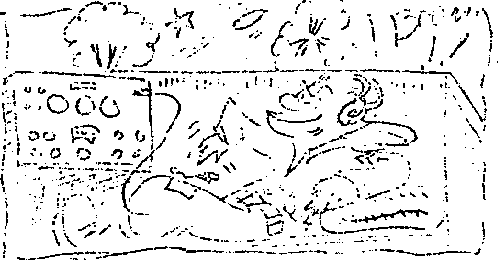
Later that afternoon, at 1340, P-51's came to our rescue and straffed enemy infantry and artillery positions that had been firing on Trains area. Heavy casualties, as well as damages to enemy equipment was inflicted. A German column, caught on the road in the town adjacent to our area, was worked over thoroughly by the P-51's during the same operation. It was a pathetic but comforting sight to see the many bodies of men and horses and wrecked vehicles and equipment strewn along the road.
A few days later two of the enemy, surviving the straffing of their column, decided to give themselves up after hiding in the town. They made their way to the chow line one morning as the unit was eating breakfast.
It was during this period that the MP Platoon, then under Trains command, and members of the Band repulsed an assault of approximately 1200 enemy troops who attempted to free Lt General Spang, Commander of the 256th German Infantry Division. General Spang was the prize captive of the 6th Armd Div and was being taken to Corps. One of the guards, Tec 4 Max Wiegand, Panther Bandsman, said that the Germans made it very hot for a while but that they failed to accomplish their aim. General Spang was still our prisoner.
An incident occurred one afternoon during our stay at Plouvian that was amusing to us but tragic to the enemy. About 500 yards down the road that ran alongside the bivouac area, a burst of machine gun fire was heard. Upon investigating, we diwscovered that a member of the FFI got a little irked when one of his six German prisoners tried to escape. So assuring himself that there would be no similar eventualities, he shot all six.
In the evening of August 12th, at 1830 hours, General Grow, Commander
of the Sixth, awarded the Bronze Star Medal to Lt. Col. Droste, Major Shoemaker,
Maj. Bogen, Captain Marsden and Sgt. Frye in recognition of Meritorious
Service.
On the afternoon of August 22 at 1230 a report was recieved of the death of Chap. Schwer and his driver Tec 5 Nelson, who were ambushed in the vicinity of Ruelgoat.
In the vicinity of Plouay on August 23rd, the Band, filled with enthusiasm and a desire to get astride the musical saddle once again, unpacked their instruments and the first rehearsal in France got under way. Preparations were being made for the coming Division frmation.
On August 25th at 0900, the first Division formation was held in the vicinity of Plousy. It was a memorial service in which General Grow honored those valiant comrades who had fallen in battle. A salvo from the guns of the 603rd TD Bn was fired in their honor. The fire was directed toward the port of Lorient, where elements of the Division was holding the sealed off German garrison there. The Commanding General also reviewed the Divisions accomplishment in its drive to BREST, and also previewed the future operations with full confidence and determination.
A static situation prevailed for the remainder of the month, with only a minimum of military activity. An entertainment program was inaugurate with informal swing concerts presented by both Bands, and movies under the supervision of the Special Service Officer, Capt. Shipley.
During the month of August, Trains travelled 342.4 miles and since
landing in France, a total of 453 miles were covered up to August 31st.
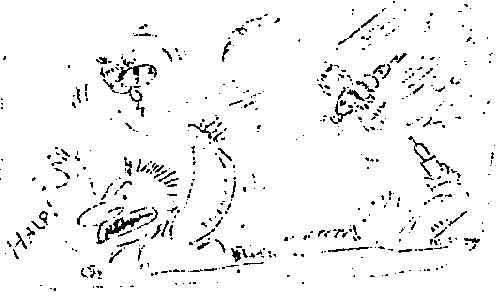
It was here, too, that any men adopted the barter system of acquiring eggs, using the Dale Carnegie approach and maybe a bar of soap or two. Everything went well until Pfc Dick Scott, later to become known as the "David Harem" of Huntington, Ind. raised the value of the common egg by offering free, a "Haircut pour Papa"!
Early in the morning of September 10th, at 0615, Trains rolled from the area and began the long journey that was to take us clear across the heart of France. Traveling a distance of 302.1 miles, we probably never saw more than could be seen on a Koch's Tour of France in peace time. We noted with keen interest the historic city of Orleans, and it's famed Cathedral, slightly damaged but standing solemnly as a symbol of religious freedom.
Arriving at the new area, in the vicinity of Lorris, Trains went into bivouac at 2115 hours. This was the termination of the longest single move made by Trains, and every one of us was exhausted. A new record was set when a mass operation of sliding into bedrolls got under way. I dare say that there wasn't a man in the organization who was not into the prone position some five minutes or so after the lead vehicle halted.
Our bivouac site was a densely wooded pine forest, and a narrow dirt road ran alongside, branching off from the main highway. For the first day or two we were mainly engaged in clearing away brush and making paths leading to and from the CP and the kitchen tents. On one occasion a bull-dozer was employed in clearing away heavy foliage and fallen branches. White tape lines were strung as night guides to the CP tent and also to the latrines; for, at night, a pine forest is the darkest place on earth. Pup tents were erected and the living quarters inside made as comfortable as possible. Still there were times during the night when an unnoticed pine cone would make an itching appearance, and a beautiful dream would be shot to Hell.
The situation here was relatively inactive and while waiting for
the next move, a series of horse shoe games were a part of the daily routine.
Our duffle bags, ehich we hadn't seen since we left England, were brought
up from the Administrative Center and distributed to each individual.
We took from them all winter clothing in preparation for the coming months.
At 1030 on the morning of September 19th Trains departed on another jaunt (he calls it that - typist) that took us to an eara 4 miles E of Saudron. We arrived there at 1907 hours and bunked down for the night. The following morning, at 0800 hours, the journey was resumed. After travelling a total of 19.5 miles since leaving the area near Lorris, Trains arrived at the bivouac site, 1.3 miles E of Martigny, at 1010 hours.
The next two days were quiet and uneventful. The only spice to add variety was the serving of several tasty meals by the kitchen crew. Captured stores of German army rations were skillfully prepared, and such menus as stek and mushrooms, spiced pickles, asparagus, apple sauce and dates were the mess kit specialties. Cases of wine were also brought in and the contents distributed. Sgt Elkins gave each man one bottle as he passed through the chow line. The drink-fest that followed was one of sober consequences, for anything similar between the wine and anything stronger was purely imaginary.

On September 23d, at 0745, Trains embarked upon a new adventure that was, to say the least, destined to add a memorable chapter in the history of Trains.
As the long convoy rumbled along the travel-weary roads, tension and anxiety mounted. We moved on and on, and it seemed that we would never halt. On either side artillery positions and AAA units were set up and on the alert. We moved ever forward. Combat troops stopped and stared at us in amazement as we passed them by. We regarded them with the same bewilderment.
Branching off onto a dirt road that later became a quagmire, as a result of an incessant downpour, we ultemately (sic) arrived, at 1215, in Gramecey Forest. There we bivouaced, with CCB on our left, and the Germans on our front. Of course, at the time we never knew just how close we were to being a front line unit, but most of us had a sneaking suspicion that it wasn't very far. Elaborate fox-holes were dug in preparation for any eventuality. Intermittent (sic) artillery barrages, coming from directly behind and firing over us, gave a little feeling of protection as well as a sleepless night. A few German shells fell in the vicinity of the Truck Park. During the night the guards struggles to make their ways to and from their post in the inky darkness. Mud was ankle deep. Generally, the situation was far from pleasant.

The next day, at 1300, Trains moved from the area under a blanket
of rain. Spirits were high as Gremecey Forest faded into the distance.
On September 27th, at 1645 hours, Trains moved to the city of Nancy. There we went into building and were quartered in the Rommel Barraks, a former German army garrison. For the remaining days of September and throughout the month of October and early November, Trains personnel enjoyed the comforts and conveniences that are not to be found in the field. Spacious rooms and bunks with straw mattresses replaced the pup tents and the hard ground. Generators furnished a little light for the rest of the rooms. Considering what we had been through, it was little less that (sic) a life of luxury. But, on the other hand, this also brought back the trials of garrison routine. Reville, calisthenics, and retreat formations, with numerous supplements in between, formed the daily schedule.
Bandsmen, temporarily relieved of their combat duties .... truck drivers, guards, code clerks, runners, etc .... were returned for musical duties. Innumerical parade and retreat formations for the combat troops, as well as playing for shows, Officer's dances, and swing concerts were among Band activities.
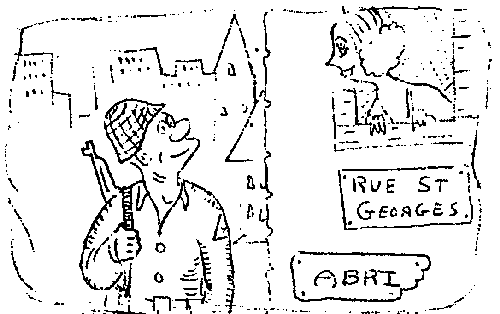
A varied entertainment program, with movies shown by the Special Service office, and traveling (sic) to USO Shows, brought hours of pleasure and relaxation. Two performances by a troop of entertainers, headed by the Hollywood Star, Marlene Dietrich, played in the 128 Ordnance area. A capacity crowd attended on both occasions.
Six and eight hour passes to Nancy were issued on a percentage
basis. Each day an alloted number would go and take in the town.
The streets were lined with more soldiers than civilians as they went their
chosen ways ... more often than
not in search of feminine companionship and a well stocked bar.
Taverns, perfume stores, and other places of soldierly interest (No. 6)
did a thriving business.
While our stay was mostly in the form of arest (sic) area, there were numerous occasions when air alerts and shelling from long range guns aroused considerable activity. Anti-aircraft and 90mm's sent up a shattering hail of fire many evenings against German planes that attempted to reconnoiter the area. For several nights 280mm shells from the enemy's long range rail-road guns attempted to inflict damages on military installations throughout the city, but as we know, without success.
After almost six weeks of an inactive encampment at the Rommel
Barracks, Trains made preparations for starting on the initial phase of
the winter campaign.
Travelling 24.8 miles, Trains arrived in Raucourt at 1000 o'clock. Pulling into fields adjoining the village, attempts were made to find suitable ground, most all of which was deep, soggy mud, where the Command Post and the kitchen tents could be erected. Finding the terrain unsuitable a party was sent out to find billets in the town. While a large number of the buildingshad felt the impact of battle, there were enough structures to comfortably house all the personnel. Trains was bivouaced here for one week, during which time overshoes and combat clothing was issued. Heavy artillery from friendly positions a few miles away gave us a noisy reception just about every night.
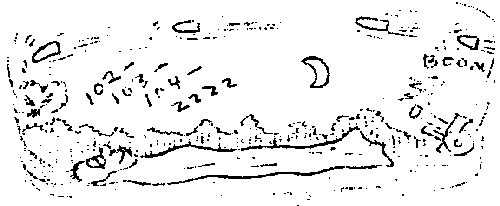
On November 18th, at 1200, Trains moved to Chateau Brehain, a distance of 38.7 miles. We were again billeted in shell-torn buildings, and living amidst a pile of rubble in one corner and a stack of hay in the other. We slushed through the watery mud as we sought to put out a straw fire that burned stubbornly from one of the buildings. As a final effort to smother the flames, the walls of the structure were torn to the ground and a bucket brigade threw a steady stream of water into the smoldering remains.
Near the Trains Aid station two dead bulls were later removed by a small number of civilians who had drifted back into the town. It was not long after that we saw the second V-1 buzz bomb as it passed directly over the area. The first was at Nancy.

On November 29th, at 0933, Trains departed from Chateau Brehain. After travelling 18.8 miles, the column arrived at Wrancaltroff at 1100 hours. For four days we were quartered in homes, some of which were inhabited by civilians.
On December 2d, at 1600, Trains moved to Lixing-les-St Avold, a short distance of only 6.2 miles from the old area. We were billeted in barracks that was once a French Army Camp, but since had been used by the Germans as a concentration camp. The brick barracks suffered somewhat from the effects of battle, but were soon turned into suitable living quarters. Excess rubble and debris was cleared away, and the basement, filled with lumber and hardware, was emptied and later used as a storage place for duffle bags.
On December 6th, the Administration Center moved in and occupied
a section of the barracks. Also billeted throughout the camp area
were units of the 76th Medical Battalion Armored, Signal Supply, Radio
Maintenance, 16th Field Hospital, Engineer Supply, and the Quartermaster.
Movies were shown on various occasions, and Band
functions were resumed on a small scale. The military Band on
one occasions played for General Grow at Division Headquarters. The
dance Bands and small combinations played for officer's parties and dances
throughout the combat units.
The following morning, December 24th, at 0705, the column got under way. Traveling 33.9 miles, Trains entered bivouac in Metz. For three days we were billeted in large stone barracks that had been used by the Germans as an OCS garrison.
Christmas, 1944, was just another day of War (sic). There was nothing joyous about the occasion. Everyone was more concerned with the German break-through in the Ardennes, where Americans were being killed unmercilessly and a critical situation had to be faced.
During the afternoon we were alerted for a possible move the next day. A little anti-aircraft activity that night was a further reminder that Christmas was far from home.
On December 27th, at 0545, Trains moved from the city of Metz. Shortly after crossing the border into Luxembourg, the column arrived in Rollingen, at 1245 hours, after traveling 48.7 miles. For two days we were billeted in an attractive house built along colonial lines. Caretakers lived in small adjoining structures and were friendly and cooperative.
We witnessed another robot bomb on December 29th, at 1510, as it passed directly over the command post. An hour later Trains left the area, moving back through the city of Luxembourg, we headed north-west into Belgium.
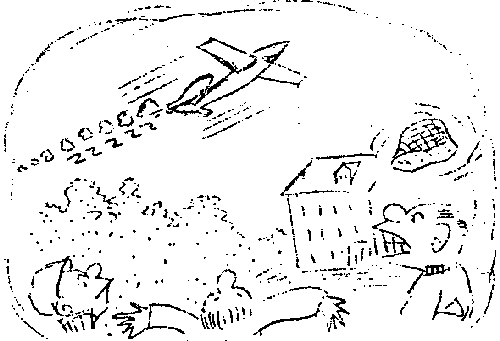
At 0710, Trains Headquarters and the Trk. Park arrived in Stockem, a distance of 30.7 miles from the old area.
For the next two weeks the Division was engaged in the hardest fighting of the War (sic), braving bitter cold and snow and facing a determined enemy. During that period Trains biggest task was supplying ammunition, for the Tank and artillery battalions were shooting the amunition, mostly 105'2, as fast as we could supply them. Trucks of the 642 Quartermaster Troop Transport Company, and units of the 3803 Quartermaster Truck Company were rolling day and night in order that the units never be faced with a shortage. Bandsmen were detailed to load and unload the cargo at critical moments.
Stockem, Belgium will always be remembered by members of Trains Headquarters as the village where friendliness and hospitality was reflected by the townspeople with sincere enthusiasm. Never before were we so treated. Many soldiers were living in private homes and eating meals prepared by the people who regarded them with high esteem. We became part of the family, and shared cheerfully witht hem a part of our rations. A few cigarettes or a bar of chocolate was like handing them unknown luxuries on a silver platter. In the few taverns of the village we milled around the bar and joined in the festive merriment. Some of the owners spoke excellent English. The people of Stockem impressed us very much, and for their kindness and cordiality we were ever grateful.
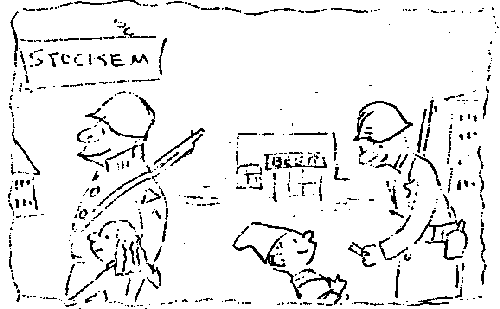
One week later, on January 21st, Trains again moved....this time to what was once bloody Bastogne. After traveling a distance of 19 miles, we arrived at the famous war-torn city at 1222 in the afternoon. Converting battle weary buildings into fairly comfortable living quarters was a major problem. In many of the billets windows were out and trash and debris was strewn throughout the rooms. Several days were required for policing and a general straightening up campaign, after which a fair amount of comfort could be had.
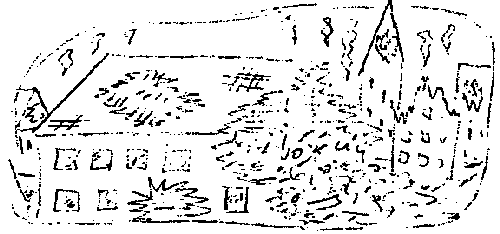
We lived and worked for three weeks amidst the wreckage of Bastogne and, when the opportunity permitted, surveyed the ruins from vantage points along the by-roads and fields. We saw not one building that escaped at least some damage. Most of them were hit badly. All over the area emptry shell casings were littered, as well as stacks of ammunition that had never been used. Knocked-out German tanks and wrecked vehicles and equipment were evidence of the bitter struggle of only a few weeks before. The dead carcasses of horses and cattle lay just as they had fallen. It was a greusome picture. To those who fought and lived through the ordeal, the battle of Bastogne will always remain in their minds as a night mare in HELL.
On February 12th, at 0945, Trains moved to a new area. Crossing the border into Luxembourg, the column proceeded to Wiltz Trains went into bivouac, at 1100, having covered a distance of 12.6 miles. We stayed at Wiltz for two weeks during which time we were billeted in homes iin (sic) the area of the Command Post. The CP and some of the personnel were quartered in an elaborate white mansion that was owned by one of the prominent and wealthy citizens of the town. A theatre, situated on a hill overlooking the main thoroughfare, was operated by the Special Service Office, and movies were shown daily. On special occasions the dance bands alternated and played a short program before and after each show.
On February 27th, at 0900, Trains departed from the area of Wiltz. This move saw our initial entry into Germany; for after crossing the Our River, near Dasberg, we were in enemy territory. Proceeding on, the column arrived in the village of Daleiden, at 1120, having travelled 19.9 miles. For the following 10 days we were billeted in small wooden barracks, formerly occupied by German soldiers. We noted with interest the reaction of the civilians as we passed through their villages and over their land. Seeing white flags flying from windows was something new, and we wondered just how the people felt then as they previewed the the first scenes of defeat. Some stared with cold hatred in their eyes....some regarded us with confusion and dismay; then there were those who didn't seem to care one way or the other. In the area around the barracks, a number of German teller mines were found. They were later detonated by a small group of Engineers.
On March 4th, the 6th Armored Division, after approximately 221 consecutive days of combat, was put in SHAEF reserve. Being temporarily relieved from the Third Army, the Division was assigned to the Seventh Army and for the next few days...
++++++++++++++++++++++++++++++++++++++
![]() PAGES 11 THROUGH
17 ADDED 26-MAY-1998
PAGES 11 THROUGH
17 ADDED 26-MAY-1998
++++++++++++++++++++++++++++++++++++++
preparations were made for moving to the XV Corps Zone in France.
Trains bivouaced in Chateau Salins for a week and a half, and there was practically no activity other than preparing for future operations. Twelve-hour passes were given to the city of Nancy. Those who filled the quota found the city had lost much of the local color that fascinated them on previous visits. With certain places OFF LIMITS it just wasn't the same any more.
During the period the band played for a Division formation, at which time General Grow summarized the accomplishments past and outlined briefly the strategy of the coming operations.
On March 19th, a few days after the Div. maoved from the assembly area into combat, Trains moved from Chateau Salins. Travelling a distance of 50.5 miles, Trains bivouaced in the field in the vicinity of Bining, at 1245. We were living on God's green earth again and improvised pup tents took on many shapes and sizes, designed for extra height and space. The maintenance crew, as well as Pfc Dick Scott's barber shop, was situated in an isolated pill box.

On March 21st, at 0800, Trains rolled again and crossed the border into Germany. On March 22d, shortly after midnight, one enemy was killed near the guard post when he failed to halt. Tec 5 Teddy Feldman and Pfc Ginaro Quaglio, sentinels on duty at the time, observed the enemy walking along a road smoking a cigarette. When ordered to halt he fled towards the woods and was shot by Cpl Feldman, manning the .50 Cal. machine gun.

On March 22d, at 0725, Trains moved to the vicvinity of Gollheim, after covering a distance of 137.8 miles. Not long after pulling into bivouac a German jet propelled plane flew over. Not knowing what it was at the time, (it sounded like a shell coming in) we ducked for cover. A report came in later that the plane had straffed the 128th Ordnance Maintenance Battalion column. For the following three days many prisoners were taken. A small number of Lugers and P-38's were highly prized souveniers for a fortunate few. Five prisoners were taken the first day. Small scouting patrols of five or more roamed the woods in search of stray Germans, witht the hope that they might be carring (sic) pistols. On March 23d two prisoners were taken by the guards. The following day the biggest catch in the area netted Trains Headquarters 20 bewildered German PW's. The total number taken by Trains during the Seventh Army Operations was 141.
At 1200 hours, on March 25th, the 6th Armored Division was released
from the XV Corps, Seventh Army, and rejoined the Third Army, in the XII
Corps.
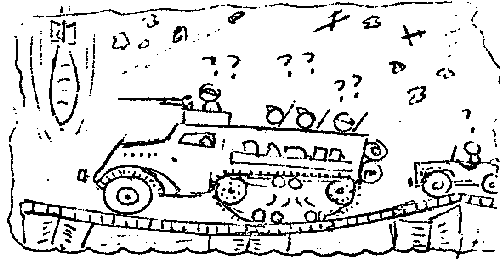
At 2005 Trains cleared the assembly area and proceeded to the vicinity of Oppenheim. North of the village, Trains crossed the Rhine River over the Oppenheim bridge, at 2320. At 0145, March 26th, Tns pulled into bivouac in the vicinity of Darnberg, 13.9 miles from the assembly area. It was not long after that enemy planes appeared and dropped bombs near Division Headquarters. On the following day Trains moved again. We entered bivouac at 1600, in the outskirts of Frankfurt, north of Sprendling. A distance of 15.8 miles was covered.
On March 28th, the 6th Armored Division was relieved from the XII Corps, and was assigned to XX Corps, Third Army.
On March 25th, at 0940, Trains moved 48 miles to the vicinity of Grueingen. Eighty-nine prisoners were taken by the 642 Truck Co., and twenty by Trains were taken during the evening.
On March 31st another move was made, and Trains arrived near the city of Homburg. A distance of 53.9 miles had been travalled from the old area. Enemy planes were over during the morning of April 2d, and straffed the road. That was the only activity.
On April 2d, at 1800, Trains moved to the vicinity of Pfieffe, arriving there at 2115. 22.5 miles were covered during the move. The Command Post and some of the personnel was billeted in the village school house. Two days later, a soldier from the 9th Armored Infantrey Battalion reported a ration truck had hit a land mine near the village of Edmeden, some 15 miles or so to the North, and a companion was penned (sic) down by enemy fire. Trains S-3, Captain Jack Marsden, borrowed a light tank from the 128 Ordnance Maintenance Battalion shops and, along with his peep (sic) driver, Tec 5 Lindsay, and an ambulance, set out to free the man and at the same time reconoiter the area. During the action that followed, far more of the enemy was encountered than was anticipated. The tank was forced to withdraw, and Cpl Lindsay was killed.
On April 5th, at 1020, two enemy planes flew very low over the area. A short burst from the guns of the 777 AAA sent one of them crashing into the woods about a half mile away. The other plane was last seen fading into the horizon.
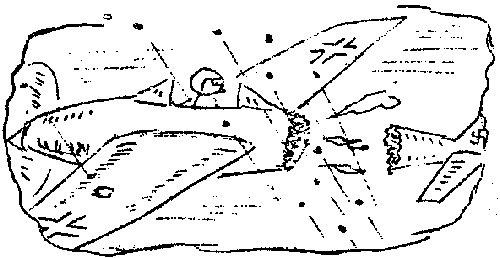
Shortly after, at 1030, Trains moved from Pfieffe, travelling 41.5 miles to the town of Neiderdorla. Soon after our arrival, at 1430, a record number of enemy aircraft, approximately 40, was seen hovering menacingly over the village. Due to heavy AAA activity no real damage was inflicted, although a number of anti-personnel bombs were dropped on the 128th Ordnance column. The following morning, at 0800, more air activity was seen as six enemy planes flew over.
For one week Trains was bivouaced in Neiderdorla, being comfortably
billeted during that time in buildings. On April 12th, at 0545, Trains
again moved. After travelling 52 miles, the column pulled into bivouac
in the field overlooking the town of Buttstadt. At 1130, two enemy
planes flew over the area very low, apparently not realizing that AAA units
were in the area. It didn't take them long to find out, for a
hail of fire soon sent both planes plummeting to the earth in flames.
On April 13th, at 0545, Trains moved to a new area, some 25 miles distant, in the vicinity of Schlolen. With the Divisions Combat Commands meeting virtually no opposition, Trains moved almost daily in the last days of the war. It was truely (sic) a ratrace, and equalled, if not surpassed, the drive made in the Brittany Campaign.

On April 24th [sic -- probably 14th] , at 0545, Trains moved 11 miles to an area in the vicinity of Meineweh. This brought us near the end of a long hard road. We had not much farther to go.
On April 15th, at 1050, Trains moved to a new area, near the town of Geithain, after travelling a distance of 43.8 miles. With the Combat elements of the Division having reached the limited line, the Mulda River, this was the last operational move made by Trains. For the next week and a half we were sweating out V-E day, anticipated daily.
On April 25th, Trains moved from the field into barracks at the Altonberg airport, near the city of Altenberg, 17.8 miles from the old area. There was loot to boot in the palatial surroundings that once housed officers of the Luftwaffe. For the first few days there was a mad scavenger hunt for any and every thing of souvenier value. After that there was nothing left and we settled back into a life of garrison.
May 8th, was Victory in Europe Day. The War was over. After a gruelling 10 months of combat, it was a little difficult to realize that the long awaited moment had arrived. It meant the end of 10 long months of enduring hardships and

discomforts that go hand in hand in winning the Peace. It meant the end of working in close harmony and cooperation with every one on the team. It meant the end of Nazi domination in Europe forever. It meant VICTORY.
THE END
Abbott, Gilbert R. Poole, KY Amminiti, Savino F. Cokburg, PA Acevedo, Robert e. Los Angeles, CA Albertini, Louigi J. Chicago, IL Boling, Claude C. Sarah, MS Bonsall, Kenneth A. Grampian, PA Bordoni, John A. Florence, NJ Bower, Richard J. Springfield, MA Brown, Edward W. Des Moines, IA Brown, John D. Stanberry, MO Browning, Walter J. Springfield, OH Brummett, Darrell L. Minden Mines, MO Benton, Robert R. Fort Wayne, IN Bruno, Carl P. Irvington, NJ Byers, Walter H. Bargersville, IN Beyler, Richard L. Alameda, CA Campagna, Santo A. New Rochelle, NY Carey, Francis P. Williamsport, PA Carr, Jessie J. Viola, TN Cesario, James Kendsha, WI Chraszez, Edward J. Detroit, MI Christenbury, James C. Mathews, NC Churchill, Robert A. Chicago, IL Clark, Cecil L. Greeley, CO Claussen, John H. Ft. Smith, AR Cocoran, Tom W. New Cambia, KS Connor, Ivan E. Pocatello, ID Conte, Gus J. New York, NY Conte, Vincent A. New York, NY Corbises, Arthur A. St. Louis, MO Costner, Harry H. Lincolnton, NC Couvillian, Duane P. Fond du Lac, WI Crawford, Paul P. Wilkensburg, PA Davis, Frank A. Little Rock, AR Davis, Gerald E. Villa Grove, IL Davis, Henry D. Sulligent, AL Deblasi, Edward Bronx, NY Decosta, Victor M. Lansdowne, PA Denker, Irving New York, NY Dietrich, Fred W. Norristown, PA Dreitz, Theodore Plains, KS Drosta, Elmer H. Hillsboro, IL Elkins, Norman E. Bloomington, IN Elwell, Arthur E. Somers Point, NJ Faust, Nathan New York, NY Flores, Ralph C. Detroit, MI Floyd, Franklyn E. Nashville, IN Flynn, John F. Madison, NJ Friedly, Norman W. Ft. Smith, AR Frye, Paul E. Virden, IL Gessner, John A. New York, NY Grimes, Hubert C. Ft. Smith, AR Guss, Peter J. Nashville, IN Gutgesell, Ernest F. New York, NY Hanley, William D. Oakland, CA Hanrahan, William H. El Cerrito, CA Harrison, Aubrey Jasper, TX Heckel, Oscar L. Hedges, Chester B. Ashville, OH Hertline, William C. Camden, NJ Hill, Thomas Magdalena, NM Himes, Robert H. Cincinnati, OH Hollrah, Dallas F. Louisville, KY Howe, Emmons L. Van Nuys, CA Hughes, Robert A. Long Island, NY Humphries, Clinton L. Anniston, AL Hurt, Joseph L. Akron, OH Isaksen, Alf Tappan, NY Istvanyi, Stephen F. New Brunswick, NJ Jennings, Walter L. Sterling, IL Johnson, Alfred Berwick, IL Johnson, Russel L. Chicago, IL Jontz, Ira H. Colfax, IA Jordan, Bruce F. Fredericksburg, TX Kammermeyer, Russell L. St. Louis, MO Kennedy, Street Eagle Springs, NC Kerr, William L. Big Run, PA Kimmell, George E. Greensburg, PA King, James R. Hartsele, AL King, Richard Anniston, AL Komineck, Richard J. Vleveland, OH Koob, Robert L. Dakota City, IA Korzep, James C. Parkersburg, WV Korzemienski, Edward Minands, NY Kosmatka, Ervin L. Milwaukee, WI Krohn, Eugene J. Bayonne, NJ Kryszczynski, Henry J. Jersey City, NJ Lasley, Lawrence A. Louisville, KY Leight, Lawrence D. Bronx, NY Lenik, Barney E. Detroit, MI Leniton, Joie Rockford, IL Lockner, Lowell T. Dubuque, IA Long, Chelsey E. Pima, AZ Loyd, Edgar W. Terre Haute, IN Maas, Frank A. Cleveland, OH Marsden, Jack F. Nashville, TN Mattenson, Louis Philadelphia, PA Mauney, Charles W. Shelby, NC McCormack, Rufus M. Gallatin, TN McKenzie, John F. Houston, TX Meehan, Joseph P. Orange, NJ Middough, George W. Quincey, IL Mofield, Simon E. Lewisville, IN Montgomery, James H. Jeffersontown, KY Mutz, Austin A. Maryville, MO O'Reilly, Norman H. Somersville, MA Overmoe, Levi Minneapolis, MN Paisley, Mida W. Helton, NC Pellegrom, Edwin J. Grand Rapids, MI Peterson, Harold B. Greensburg, PA Perlow, Stephen S. Hollywood, CA Pittman, Walker C. Meehan Junction, MS Prevenslick, Paul P. Youngwood, PA Quaglia, Ginaro Reading, PA Quillin, J.D. Wichita Falls, TX Rich, Victor T. New Kensington, PA Robertson, Alexander M. San Fernando, CA Roehre, Arthur F. Baltimore, MD Rohde, Carl H. Detroit, MI Rumenyak, Edward T. Brownfield, PA Sagan, Augustine J. New York, NY Sanner, Robert J. Johnstown, PA Schaaf, Theodore V. Cincinnati, OH Schreck, Ralph J. Meadville, PA Scott, Lawrence B. Palm Beach, FL Scott, Richard M. Huntington, IN Sease, Fred C. Columbia, SC Seiders, Frank J. Divernon, IL Sellness, Norman J. Mabel, MN Serbinski, Norman J. Chicago, IL Shirah, Fred C. Ozark, AL Shoemaker, Philip C. Kansas City, MO Sipe, Hayes B. Jones Mills, PA Smith, Abraham B. Newburgh, NY Snider, William K. Bloomfield, KY Snigger, Stephen Whitman, MA Soward, Floyd W. Lodi, OH Steinke, Edward B. Hatley, WI Steward, Carl A. Cedar Vale, KS Stoll, Richard L. Wellsville, NY Struzzi, Victor L. Manor, PA Sutker, Max Savannah, GA Szewezuk, Stanley McKees Rocks, PA Tedeschi, Fred J. Brooklyn, NY Tenkate, James Midland Park, NJ Testa, James Harverstraw, NY Thompson, Carroll W. Enid, OK Thompson, Charles C. North Hackensack, NJ Titus, Alonzo Lebanon, IN Turturiello, Anthony D. Bellerville, NJ Urton, John N. Independence, MO Vito, Alfred A. Eveleth, MN Viverrette, Marvin E. Sharpsburg, NC Voeste, John H. Wilkes Barre, PA Walden, Joseph P. Eureka Springs, AR Watkins, Norman O. Grafton, WV Weigan, Max E. Dover, OH Widegren, James V. Tiffin, OH Willis, Arthur L. Elkhart, IN Wind, Kajetan F. Milwaukee, WI Wolf, Norman A. Hollis, NY
![]() Unofficial Home Page of the 6th
Armored Division Association.
Unofficial Home Page of the 6th
Armored Division Association.
NOTE: Remove question mark from email address below when sending mail.
This page is maintained by Bruce Frederick, EMAIL
Last updated:
May 26, 1998 -- Added pages 11 through 17
May 14, 1998 -- Added pages 6 through 10
May 10, 1998 -- Created.